University Business Communication Case Study: Intercultural Barriers
VerifiedAdded on 2023/01/10
|10
|1776
|33
Case Study
AI Summary
This case study explores the barriers to effective intercultural communication in a business environment. It begins by defining the impact of factors such as traditional stereotypes, language differences, stress, ethnocentrism, prejudice, and behavioral misinterpretations on communication. The report outlines the three levels of culture (artifacts, espoused values, and underlying assumptions) and discusses the relationship between language and culture, emphasizing the importance of clear and appropriate communication. It then delves into the major hindrances to intercultural communication, including language barriers, stress, ethnocentrism, and misinterpretations. The study references key research on cultural differences in the workplace and the importance of effective communication for organizational success. The report concludes that overcoming these barriers is crucial for fostering a transparent and sustainable business environment, recommending social orientation programs and promoting a culturally diverse workplace. It also highlights the value of formal and informal communication methods, including the use of technological tools and structured reporting, to facilitate effective information exchange.
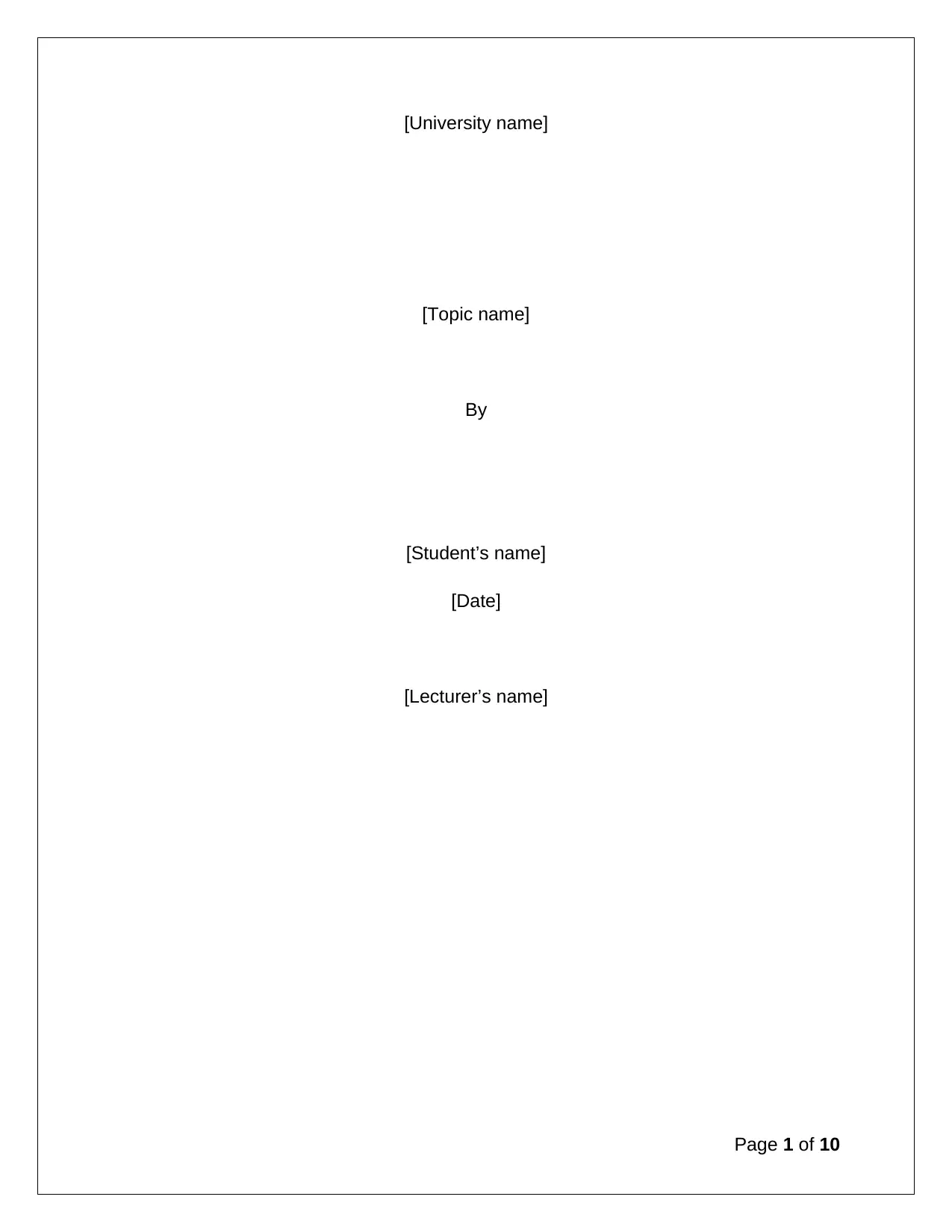
[University name]
[Topic name]
By
[Student’s name]
[Date]
[Lecturer’s name]
Page 1 of 10
[Topic name]
By
[Student’s name]
[Date]
[Lecturer’s name]
Page 1 of 10
Paraphrase This Document
Need a fresh take? Get an instant paraphrase of this document with our AI Paraphraser
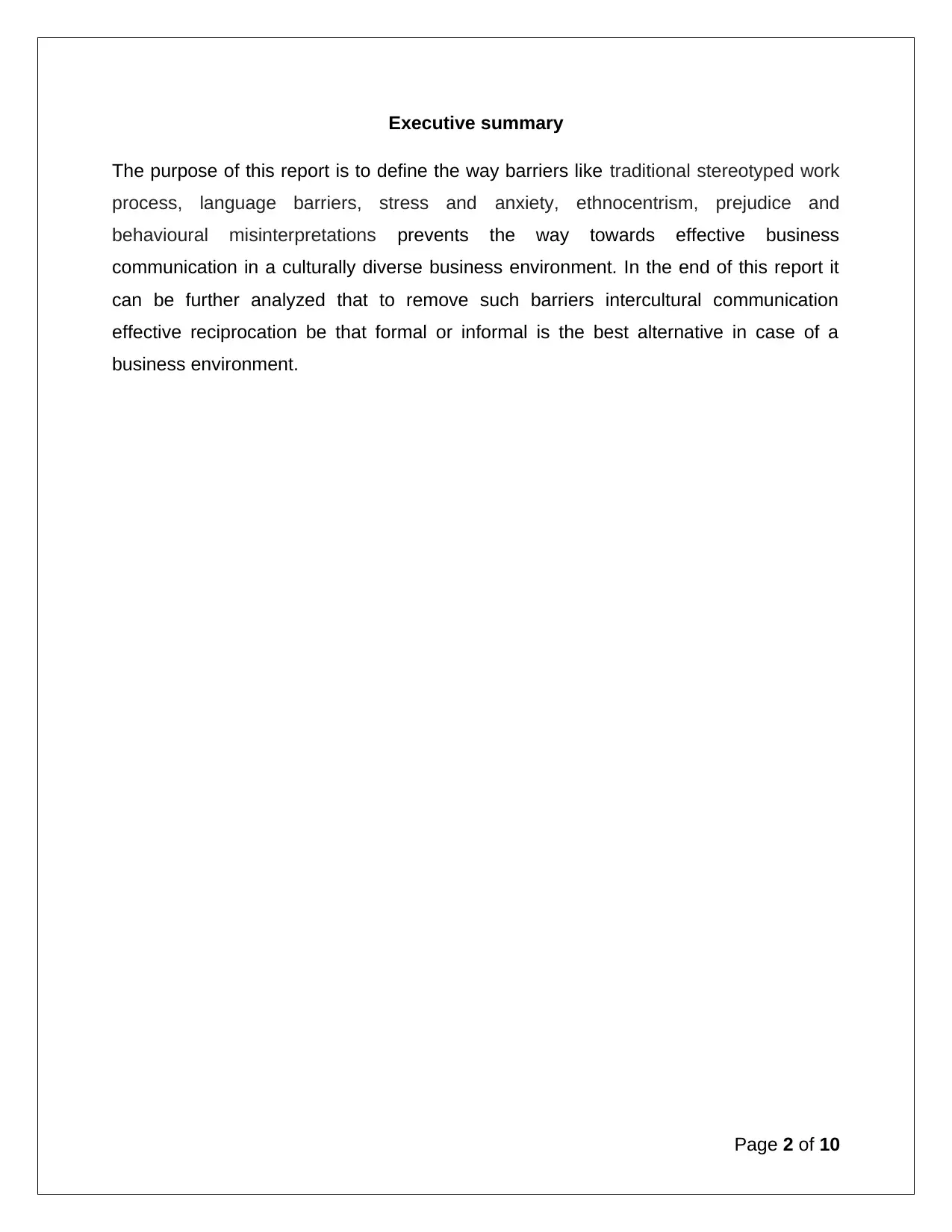
Executive summary
The purpose of this report is to define the way barriers like traditional stereotyped work
process, language barriers, stress and anxiety, ethnocentrism, prejudice and
behavioural misinterpretations prevents the way towards effective business
communication in a culturally diverse business environment. In the end of this report it
can be further analyzed that to remove such barriers intercultural communication
effective reciprocation be that formal or informal is the best alternative in case of a
business environment.
Page 2 of 10
The purpose of this report is to define the way barriers like traditional stereotyped work
process, language barriers, stress and anxiety, ethnocentrism, prejudice and
behavioural misinterpretations prevents the way towards effective business
communication in a culturally diverse business environment. In the end of this report it
can be further analyzed that to remove such barriers intercultural communication
effective reciprocation be that formal or informal is the best alternative in case of a
business environment.
Page 2 of 10
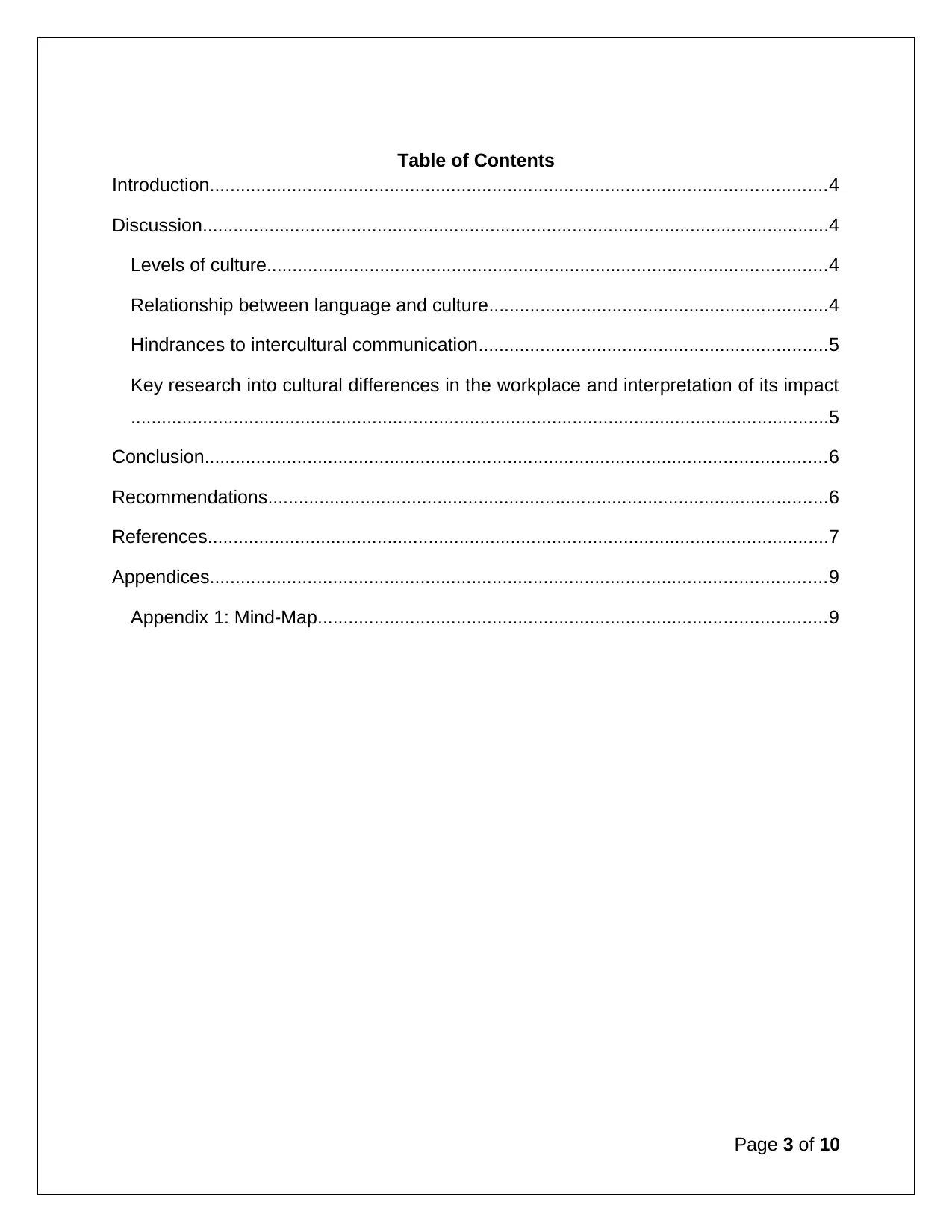
Table of Contents
Introduction........................................................................................................................4
Discussion..........................................................................................................................4
Levels of culture.............................................................................................................4
Relationship between language and culture..................................................................4
Hindrances to intercultural communication....................................................................5
Key research into cultural differences in the workplace and interpretation of its impact
........................................................................................................................................5
Conclusion.........................................................................................................................6
Recommendations.............................................................................................................6
References.........................................................................................................................7
Appendices........................................................................................................................9
Appendix 1: Mind-Map...................................................................................................9
Page 3 of 10
Introduction........................................................................................................................4
Discussion..........................................................................................................................4
Levels of culture.............................................................................................................4
Relationship between language and culture..................................................................4
Hindrances to intercultural communication....................................................................5
Key research into cultural differences in the workplace and interpretation of its impact
........................................................................................................................................5
Conclusion.........................................................................................................................6
Recommendations.............................................................................................................6
References.........................................................................................................................7
Appendices........................................................................................................................9
Appendix 1: Mind-Map...................................................................................................9
Page 3 of 10
⊘ This is a preview!⊘
Do you want full access?
Subscribe today to unlock all pages.

Trusted by 1+ million students worldwide
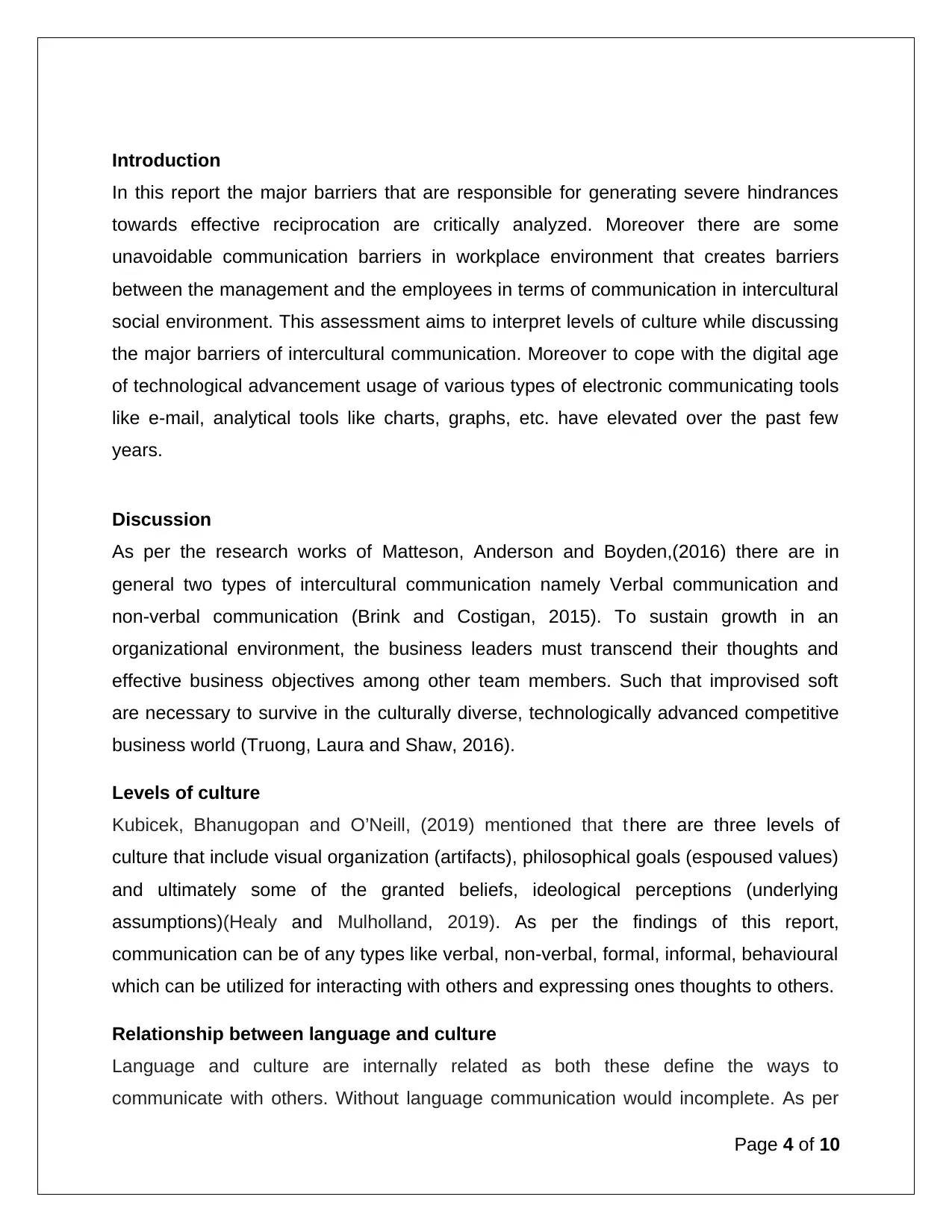
Introduction
In this report the major barriers that are responsible for generating severe hindrances
towards effective reciprocation are critically analyzed. Moreover there are some
unavoidable communication barriers in workplace environment that creates barriers
between the management and the employees in terms of communication in intercultural
social environment. This assessment aims to interpret levels of culture while discussing
the major barriers of intercultural communication. Moreover to cope with the digital age
of technological advancement usage of various types of electronic communicating tools
like e-mail, analytical tools like charts, graphs, etc. have elevated over the past few
years.
Discussion
As per the research works of Matteson, Anderson and Boyden,(2016) there are in
general two types of intercultural communication namely Verbal communication and
non-verbal communication (Brink and Costigan, 2015). To sustain growth in an
organizational environment, the business leaders must transcend their thoughts and
effective business objectives among other team members. Such that improvised soft
are necessary to survive in the culturally diverse, technologically advanced competitive
business world (Truong, Laura and Shaw, 2016).
Levels of culture
Kubicek, Bhanugopan and O’Neill, (2019) mentioned that there are three levels of
culture that include visual organization (artifacts), philosophical goals (espoused values)
and ultimately some of the granted beliefs, ideological perceptions (underlying
assumptions)(Healy and Mulholland, 2019). As per the findings of this report,
communication can be of any types like verbal, non-verbal, formal, informal, behavioural
which can be utilized for interacting with others and expressing ones thoughts to others.
Relationship between language and culture
Language and culture are internally related as both these define the ways to
communicate with others. Without language communication would incomplete. As per
Page 4 of 10
In this report the major barriers that are responsible for generating severe hindrances
towards effective reciprocation are critically analyzed. Moreover there are some
unavoidable communication barriers in workplace environment that creates barriers
between the management and the employees in terms of communication in intercultural
social environment. This assessment aims to interpret levels of culture while discussing
the major barriers of intercultural communication. Moreover to cope with the digital age
of technological advancement usage of various types of electronic communicating tools
like e-mail, analytical tools like charts, graphs, etc. have elevated over the past few
years.
Discussion
As per the research works of Matteson, Anderson and Boyden,(2016) there are in
general two types of intercultural communication namely Verbal communication and
non-verbal communication (Brink and Costigan, 2015). To sustain growth in an
organizational environment, the business leaders must transcend their thoughts and
effective business objectives among other team members. Such that improvised soft
are necessary to survive in the culturally diverse, technologically advanced competitive
business world (Truong, Laura and Shaw, 2016).
Levels of culture
Kubicek, Bhanugopan and O’Neill, (2019) mentioned that there are three levels of
culture that include visual organization (artifacts), philosophical goals (espoused values)
and ultimately some of the granted beliefs, ideological perceptions (underlying
assumptions)(Healy and Mulholland, 2019). As per the findings of this report,
communication can be of any types like verbal, non-verbal, formal, informal, behavioural
which can be utilized for interacting with others and expressing ones thoughts to others.
Relationship between language and culture
Language and culture are internally related as both these define the ways to
communicate with others. Without language communication would incomplete. As per
Page 4 of 10
Paraphrase This Document
Need a fresh take? Get an instant paraphrase of this document with our AI Paraphraser
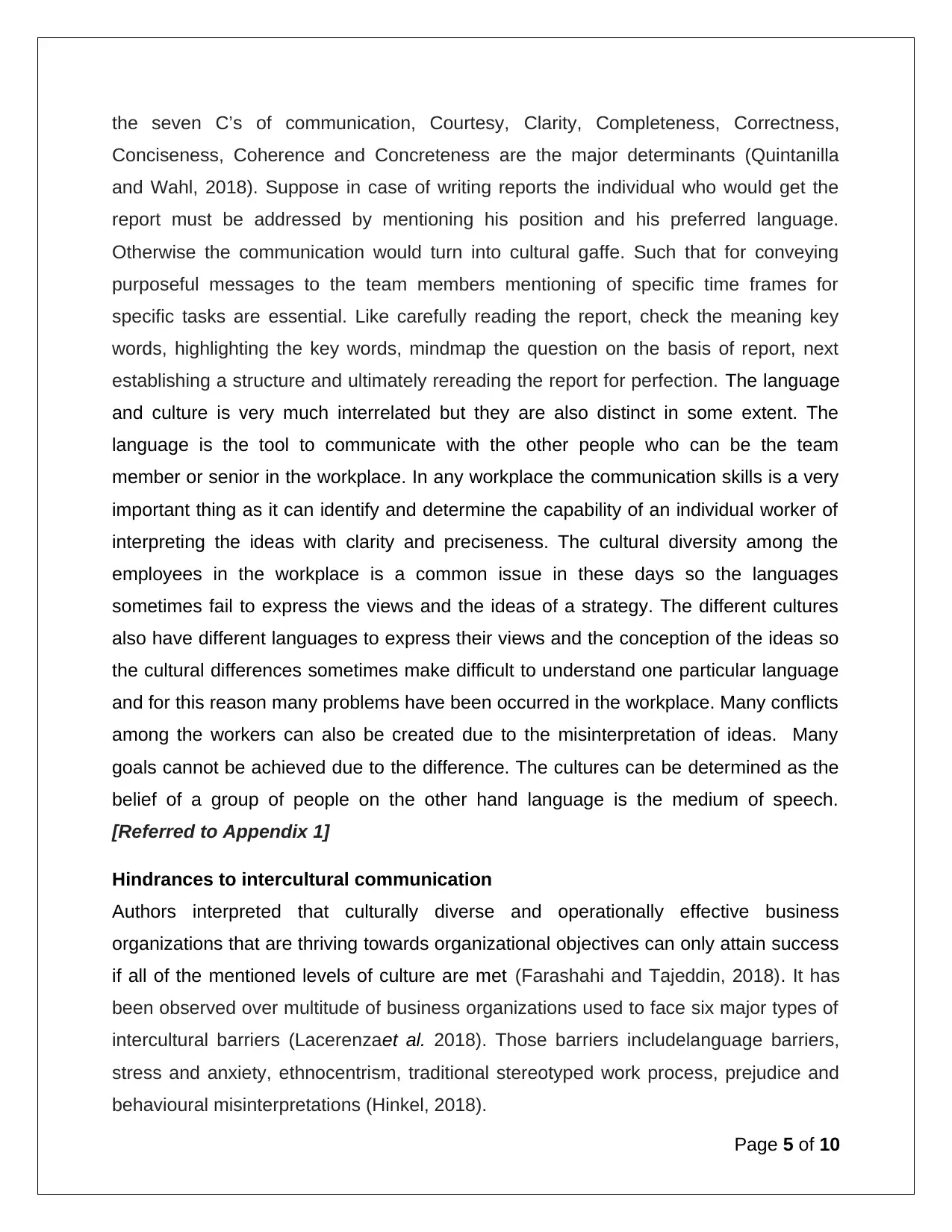
the seven C’s of communication, Courtesy, Clarity, Completeness, Correctness,
Conciseness, Coherence and Concreteness are the major determinants (Quintanilla
and Wahl, 2018). Suppose in case of writing reports the individual who would get the
report must be addressed by mentioning his position and his preferred language.
Otherwise the communication would turn into cultural gaffe. Such that for conveying
purposeful messages to the team members mentioning of specific time frames for
specific tasks are essential. Like carefully reading the report, check the meaning key
words, highlighting the key words, mindmap the question on the basis of report, next
establishing a structure and ultimately rereading the report for perfection. The language
and culture is very much interrelated but they are also distinct in some extent. The
language is the tool to communicate with the other people who can be the team
member or senior in the workplace. In any workplace the communication skills is a very
important thing as it can identify and determine the capability of an individual worker of
interpreting the ideas with clarity and preciseness. The cultural diversity among the
employees in the workplace is a common issue in these days so the languages
sometimes fail to express the views and the ideas of a strategy. The different cultures
also have different languages to express their views and the conception of the ideas so
the cultural differences sometimes make difficult to understand one particular language
and for this reason many problems have been occurred in the workplace. Many conflicts
among the workers can also be created due to the misinterpretation of ideas. Many
goals cannot be achieved due to the difference. The cultures can be determined as the
belief of a group of people on the other hand language is the medium of speech.
[Referred to Appendix 1]
Hindrances to intercultural communication
Authors interpreted that culturally diverse and operationally effective business
organizations that are thriving towards organizational objectives can only attain success
if all of the mentioned levels of culture are met (Farashahi and Tajeddin, 2018). It has
been observed over multitude of business organizations used to face six major types of
intercultural barriers (Lacerenzaet al. 2018). Those barriers includelanguage barriers,
stress and anxiety, ethnocentrism, traditional stereotyped work process, prejudice and
behavioural misinterpretations (Hinkel, 2018).
Page 5 of 10
Conciseness, Coherence and Concreteness are the major determinants (Quintanilla
and Wahl, 2018). Suppose in case of writing reports the individual who would get the
report must be addressed by mentioning his position and his preferred language.
Otherwise the communication would turn into cultural gaffe. Such that for conveying
purposeful messages to the team members mentioning of specific time frames for
specific tasks are essential. Like carefully reading the report, check the meaning key
words, highlighting the key words, mindmap the question on the basis of report, next
establishing a structure and ultimately rereading the report for perfection. The language
and culture is very much interrelated but they are also distinct in some extent. The
language is the tool to communicate with the other people who can be the team
member or senior in the workplace. In any workplace the communication skills is a very
important thing as it can identify and determine the capability of an individual worker of
interpreting the ideas with clarity and preciseness. The cultural diversity among the
employees in the workplace is a common issue in these days so the languages
sometimes fail to express the views and the ideas of a strategy. The different cultures
also have different languages to express their views and the conception of the ideas so
the cultural differences sometimes make difficult to understand one particular language
and for this reason many problems have been occurred in the workplace. Many conflicts
among the workers can also be created due to the misinterpretation of ideas. Many
goals cannot be achieved due to the difference. The cultures can be determined as the
belief of a group of people on the other hand language is the medium of speech.
[Referred to Appendix 1]
Hindrances to intercultural communication
Authors interpreted that culturally diverse and operationally effective business
organizations that are thriving towards organizational objectives can only attain success
if all of the mentioned levels of culture are met (Farashahi and Tajeddin, 2018). It has
been observed over multitude of business organizations used to face six major types of
intercultural barriers (Lacerenzaet al. 2018). Those barriers includelanguage barriers,
stress and anxiety, ethnocentrism, traditional stereotyped work process, prejudice and
behavioural misinterpretations (Hinkel, 2018).
Page 5 of 10
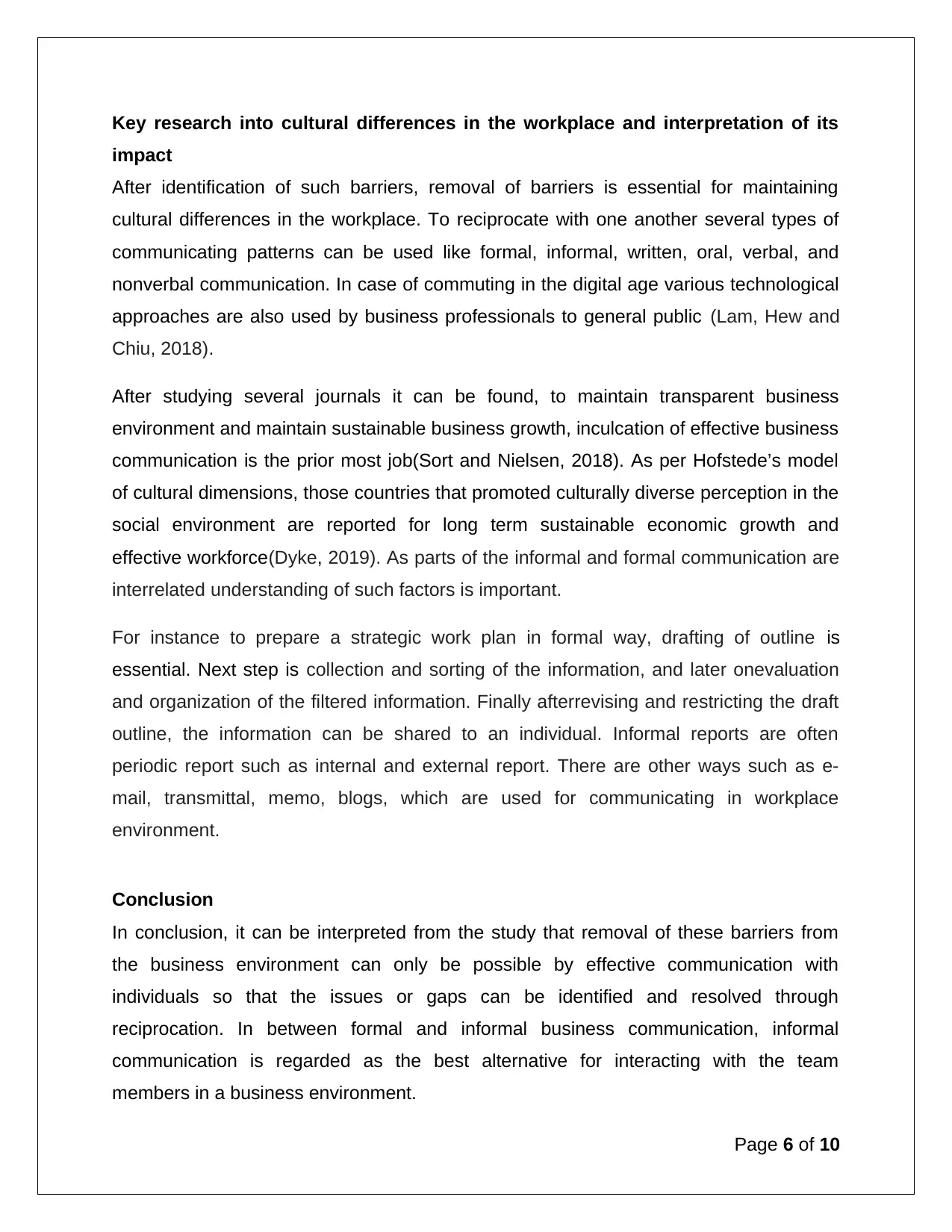
Key research into cultural differences in the workplace and interpretation of its
impact
After identification of such barriers, removal of barriers is essential for maintaining
cultural differences in the workplace. To reciprocate with one another several types of
communicating patterns can be used like formal, informal, written, oral, verbal, and
nonverbal communication. In case of commuting in the digital age various technological
approaches are also used by business professionals to general public (Lam, Hew and
Chiu, 2018).
After studying several journals it can be found, to maintain transparent business
environment and maintain sustainable business growth, inculcation of effective business
communication is the prior most job(Sort and Nielsen, 2018). As per Hofstede’s model
of cultural dimensions, those countries that promoted culturally diverse perception in the
social environment are reported for long term sustainable economic growth and
effective workforce(Dyke, 2019). As parts of the informal and formal communication are
interrelated understanding of such factors is important.
For instance to prepare a strategic work plan in formal way, drafting of outline is
essential. Next step is collection and sorting of the information, and later onevaluation
and organization of the filtered information. Finally afterrevising and restricting the draft
outline, the information can be shared to an individual. Informal reports are often
periodic report such as internal and external report. There are other ways such as e-
mail, transmittal, memo, blogs, which are used for communicating in workplace
environment.
Conclusion
In conclusion, it can be interpreted from the study that removal of these barriers from
the business environment can only be possible by effective communication with
individuals so that the issues or gaps can be identified and resolved through
reciprocation. In between formal and informal business communication, informal
communication is regarded as the best alternative for interacting with the team
members in a business environment.
Page 6 of 10
impact
After identification of such barriers, removal of barriers is essential for maintaining
cultural differences in the workplace. To reciprocate with one another several types of
communicating patterns can be used like formal, informal, written, oral, verbal, and
nonverbal communication. In case of commuting in the digital age various technological
approaches are also used by business professionals to general public (Lam, Hew and
Chiu, 2018).
After studying several journals it can be found, to maintain transparent business
environment and maintain sustainable business growth, inculcation of effective business
communication is the prior most job(Sort and Nielsen, 2018). As per Hofstede’s model
of cultural dimensions, those countries that promoted culturally diverse perception in the
social environment are reported for long term sustainable economic growth and
effective workforce(Dyke, 2019). As parts of the informal and formal communication are
interrelated understanding of such factors is important.
For instance to prepare a strategic work plan in formal way, drafting of outline is
essential. Next step is collection and sorting of the information, and later onevaluation
and organization of the filtered information. Finally afterrevising and restricting the draft
outline, the information can be shared to an individual. Informal reports are often
periodic report such as internal and external report. There are other ways such as e-
mail, transmittal, memo, blogs, which are used for communicating in workplace
environment.
Conclusion
In conclusion, it can be interpreted from the study that removal of these barriers from
the business environment can only be possible by effective communication with
individuals so that the issues or gaps can be identified and resolved through
reciprocation. In between formal and informal business communication, informal
communication is regarded as the best alternative for interacting with the team
members in a business environment.
Page 6 of 10
⊘ This is a preview!⊘
Do you want full access?
Subscribe today to unlock all pages.

Trusted by 1+ million students worldwide
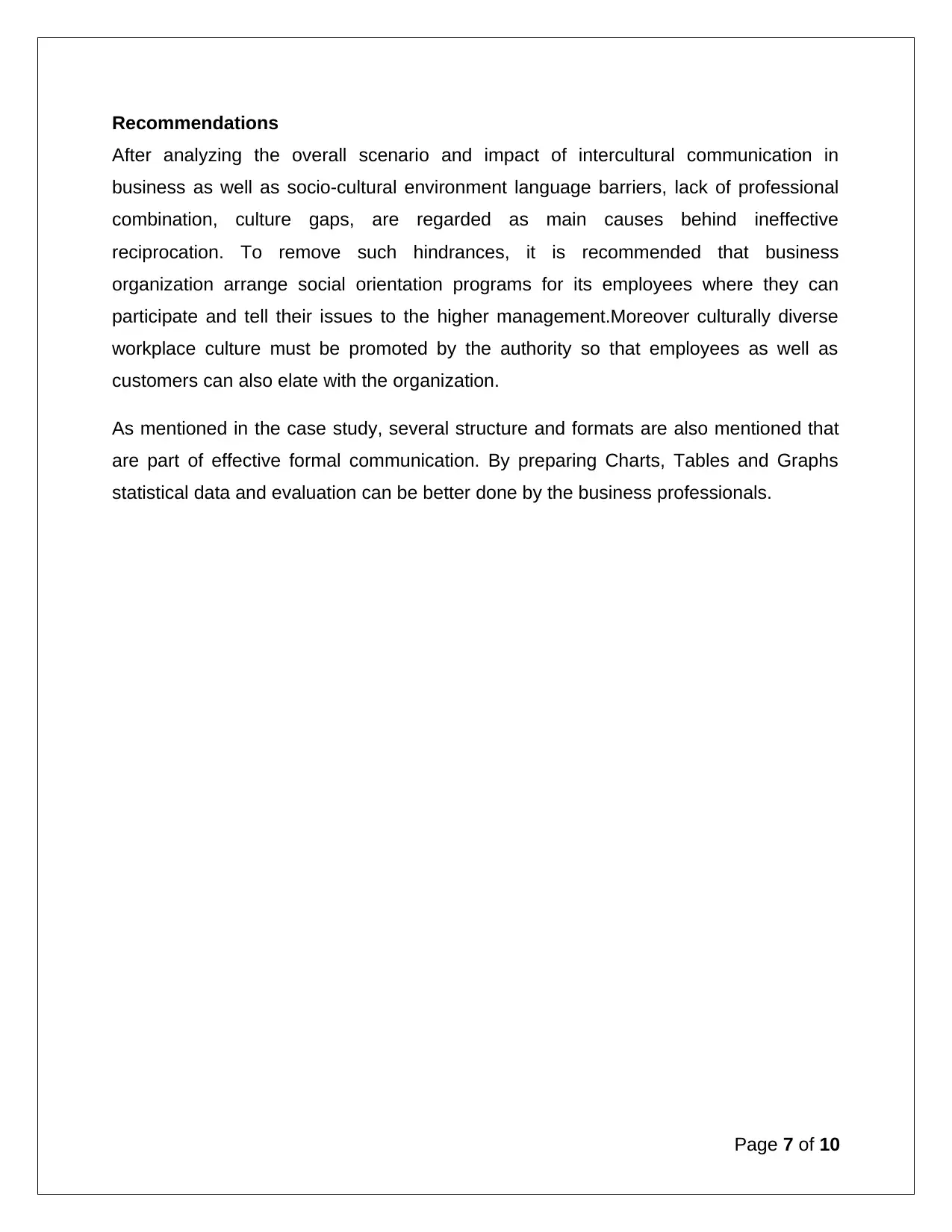
Recommendations
After analyzing the overall scenario and impact of intercultural communication in
business as well as socio-cultural environment language barriers, lack of professional
combination, culture gaps, are regarded as main causes behind ineffective
reciprocation. To remove such hindrances, it is recommended that business
organization arrange social orientation programs for its employees where they can
participate and tell their issues to the higher management.Moreover culturally diverse
workplace culture must be promoted by the authority so that employees as well as
customers can also elate with the organization.
As mentioned in the case study, several structure and formats are also mentioned that
are part of effective formal communication. By preparing Charts, Tables and Graphs
statistical data and evaluation can be better done by the business professionals.
Page 7 of 10
After analyzing the overall scenario and impact of intercultural communication in
business as well as socio-cultural environment language barriers, lack of professional
combination, culture gaps, are regarded as main causes behind ineffective
reciprocation. To remove such hindrances, it is recommended that business
organization arrange social orientation programs for its employees where they can
participate and tell their issues to the higher management.Moreover culturally diverse
workplace culture must be promoted by the authority so that employees as well as
customers can also elate with the organization.
As mentioned in the case study, several structure and formats are also mentioned that
are part of effective formal communication. By preparing Charts, Tables and Graphs
statistical data and evaluation can be better done by the business professionals.
Page 7 of 10
Paraphrase This Document
Need a fresh take? Get an instant paraphrase of this document with our AI Paraphraser

References
Farashahi, M. and Tajeddin, M., 2018. Effectiveness of teaching methods in business
education: A comparison study on the learning outcomes of lectures, case studies and
simulations. The International Journal of Management Education, 16(1), pp.131-142.
Healy, K. and Mulholland, J., 2019. Writing skills for social workers. SAGE Publications
Limited.
Kubicek, A., Bhanugopan, R. and O’Neill, G., 2019. How does cultural intelligence affect
organisational culture: the mediating role of cross-cultural role conflict, ambiguity, and
overload.The International Journal of Human Resource Management, 30(7), pp.1059-
1083.
Lacerenza, C.N., Marlow, S.L., Tannenbaum, S.I. and Salas, E., 2018. Team
development interventions: Evidence-based approaches for improving teamwork.
American Psychologist, 73(4), p.517.
Lam, Y.W., Hew, K.F.T. and Chiu, K.F., 2018. Improving argumentative writing: Effects
of a blended learning approach and gamification. Language learning
&technology.Matteson, M.L., Anderson, L. and Boyden, C., 2016. " Soft Skills": A
Phrase in Search of Meaning. portal: Libraries and the Academy, 16(1), pp.71-88.
Quintanilla, K.M. and Wahl, S.T., 2018. Business and professional communication: keys
for workplace excellence. Sage Publications.
Truong, H.T., Laura, R.S. and Shaw, K., 2016. New insights for soft skills development
in Vietnamese business schools: Defining essential softskills for maximizing graduates’
career success. Int. J. Soc. Behav. Educ. Econ. Bus. Ind. Eng, 10, pp.1857-1863.
Sort, J.C. and Nielsen, C., 2018. Using the business model canvas to improve
investment processes. Journal of Research in Marketing and Entrepreneurship, 20(1),
pp.10-33.
Page 8 of 10
Farashahi, M. and Tajeddin, M., 2018. Effectiveness of teaching methods in business
education: A comparison study on the learning outcomes of lectures, case studies and
simulations. The International Journal of Management Education, 16(1), pp.131-142.
Healy, K. and Mulholland, J., 2019. Writing skills for social workers. SAGE Publications
Limited.
Kubicek, A., Bhanugopan, R. and O’Neill, G., 2019. How does cultural intelligence affect
organisational culture: the mediating role of cross-cultural role conflict, ambiguity, and
overload.The International Journal of Human Resource Management, 30(7), pp.1059-
1083.
Lacerenza, C.N., Marlow, S.L., Tannenbaum, S.I. and Salas, E., 2018. Team
development interventions: Evidence-based approaches for improving teamwork.
American Psychologist, 73(4), p.517.
Lam, Y.W., Hew, K.F.T. and Chiu, K.F., 2018. Improving argumentative writing: Effects
of a blended learning approach and gamification. Language learning
&technology.Matteson, M.L., Anderson, L. and Boyden, C., 2016. " Soft Skills": A
Phrase in Search of Meaning. portal: Libraries and the Academy, 16(1), pp.71-88.
Quintanilla, K.M. and Wahl, S.T., 2018. Business and professional communication: keys
for workplace excellence. Sage Publications.
Truong, H.T., Laura, R.S. and Shaw, K., 2016. New insights for soft skills development
in Vietnamese business schools: Defining essential softskills for maximizing graduates’
career success. Int. J. Soc. Behav. Educ. Econ. Bus. Ind. Eng, 10, pp.1857-1863.
Sort, J.C. and Nielsen, C., 2018. Using the business model canvas to improve
investment processes. Journal of Research in Marketing and Entrepreneurship, 20(1),
pp.10-33.
Page 8 of 10
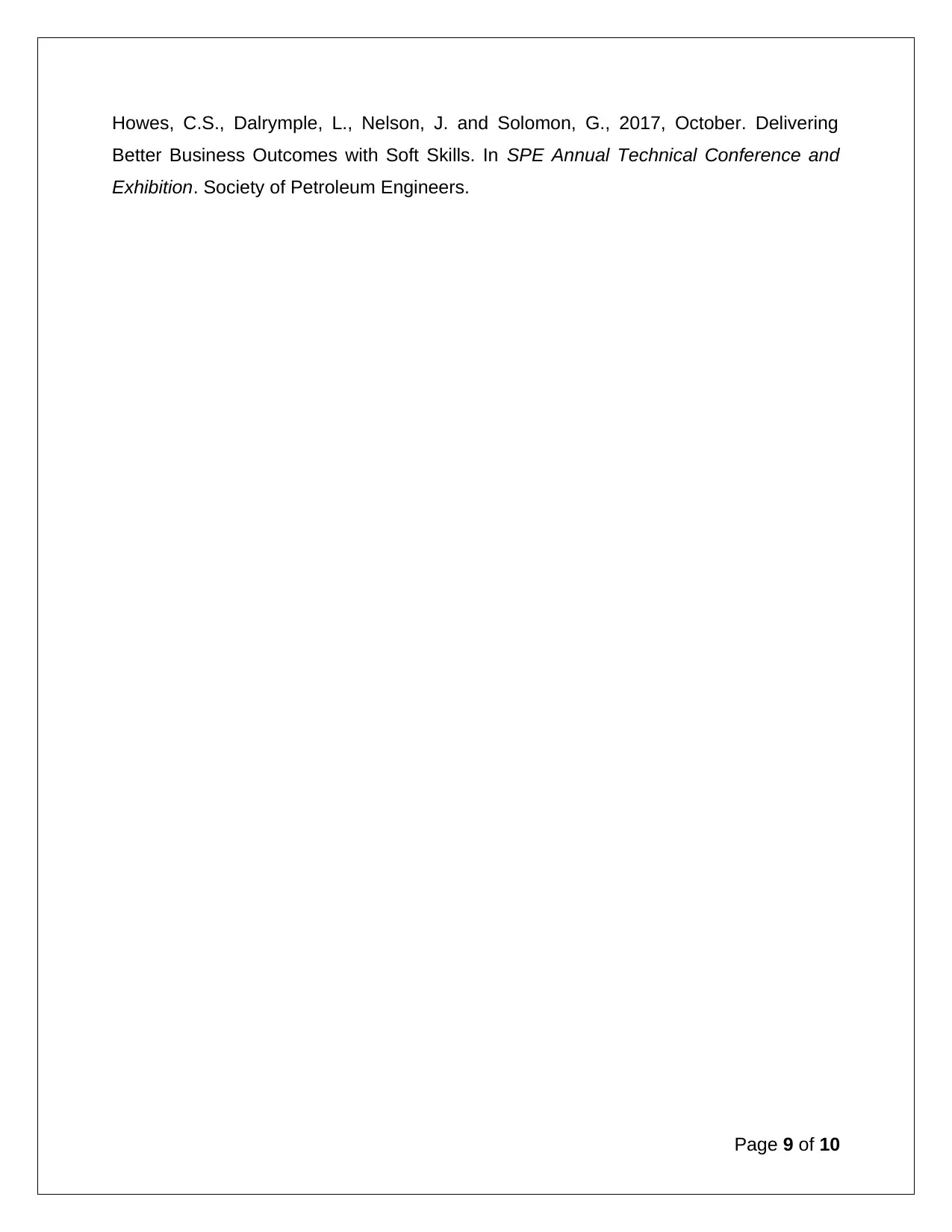
Howes, C.S., Dalrymple, L., Nelson, J. and Solomon, G., 2017, October. Delivering
Better Business Outcomes with Soft Skills. In SPE Annual Technical Conference and
Exhibition. Society of Petroleum Engineers.
Page 9 of 10
Better Business Outcomes with Soft Skills. In SPE Annual Technical Conference and
Exhibition. Society of Petroleum Engineers.
Page 9 of 10
⊘ This is a preview!⊘
Do you want full access?
Subscribe today to unlock all pages.

Trusted by 1+ million students worldwide
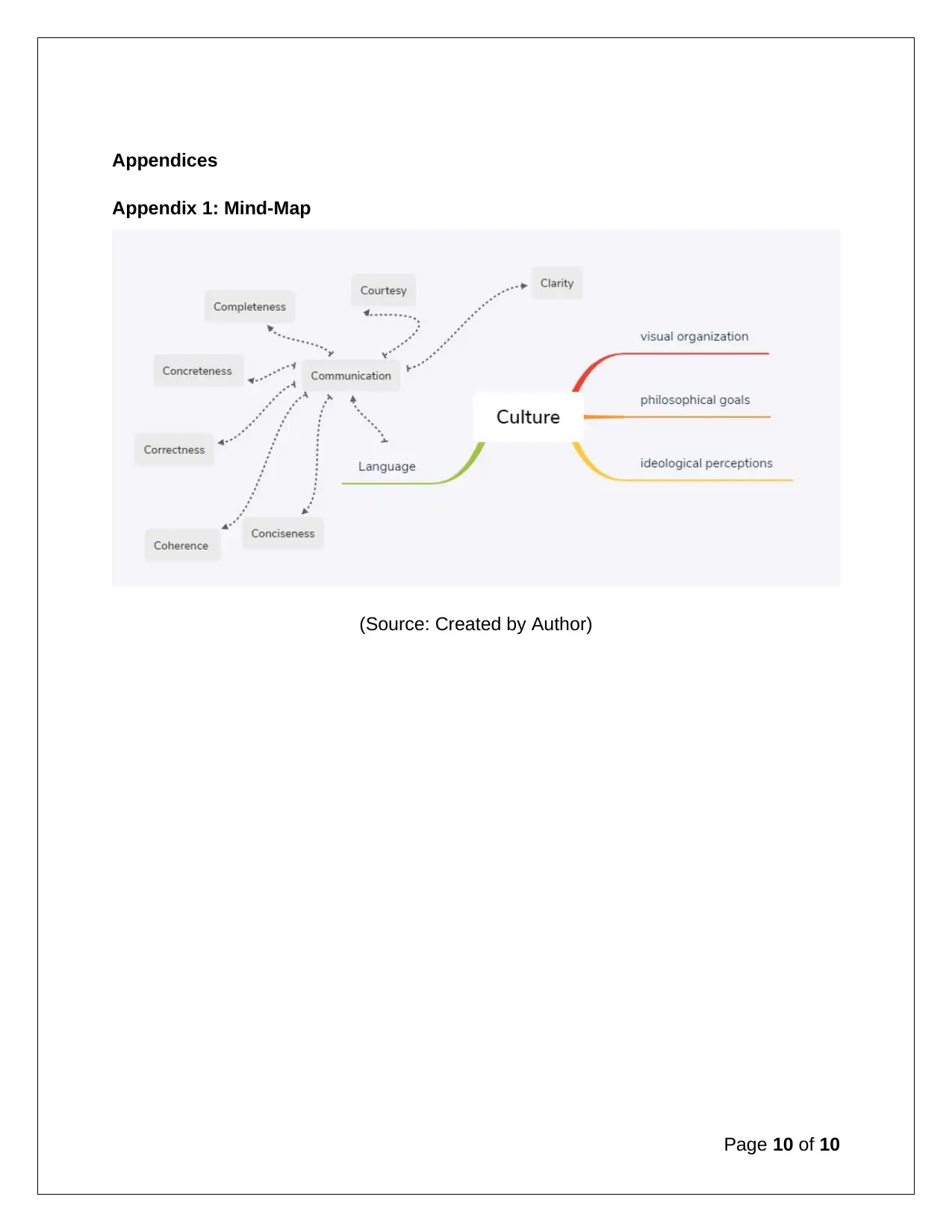
Appendices
Appendix 1: Mind-Map
(Source: Created by Author)
Page 10 of 10
Appendix 1: Mind-Map
(Source: Created by Author)
Page 10 of 10
1 out of 10
Related Documents
Your All-in-One AI-Powered Toolkit for Academic Success.
+13062052269
info@desklib.com
Available 24*7 on WhatsApp / Email
![[object Object]](/_next/static/media/star-bottom.7253800d.svg)
Unlock your academic potential
Copyright © 2020–2025 A2Z Services. All Rights Reserved. Developed and managed by ZUCOL.


